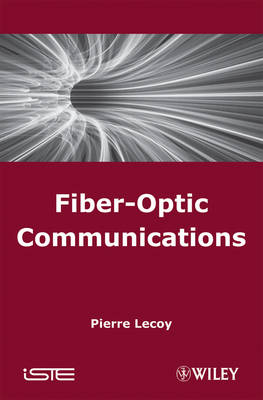
Fiber-Optic Communications
ISTE Ltd and John Wiley & Sons Inc (Verlag)
978-1-84821-049-3 (ISBN)
- Titel ist leider vergriffen;
keine Neuauflage - Artikel merken
This book describes in a comprehensive manner the components and systems of fiber optic communications and networks. The first section explains the theory of multimode and single-mode fibers, then the technological features, including manufacturing, cabling, and connecting. The second section describes the various components (passive and active optical components, integrated optics, opto-electronic transmitters and receivers, and optical amplifiers) used in fiber optic systems. Finally, the optical transmission system design is explained, and applications to optical networks and fiber optic sensors are detailed, including the most recent developments in switched networks, high bit-rate systems, and FTTH or radio over fiber.
Pierre Lecoy is the author of Fiber-Optic Communications, published by Wiley.
Foreword xvii
Introduction xxi
Chapter 1. Multimode Optical Fibers 1
1.1. Overview of optics 1
1.1.1. Introduction 1
1.1.2. Propagation of harmonic plane waves 1
1.1.3. Light rays 3
1.1.4. Dielectric diopter 4
1.1.5. Reflection of a plane wave on a diopter 6
1.1.6. Reflection coefficient 7
1.1.7. Total reflection 8
1.2. Dielectric waveguide 10
1.2.1. Planar dielectric waveguide model 10
1.2.2. Notion of propagation modes 11
1.2.3. Case of the asymmetric guide 13
1.2.4. Dispersion 14
1.3. Multimode optical fibers 15
1.3.1. Definition 15
1.3.2. Multimode step-index fiber 15
1.3.3. Multimode graded-index fiber 17
1.4. Propagation in multimode optical fibers 18
1.4.1. Ray paths 18
1.4.2. Propagation equation resolution 19
1.4.3. Different ray types 20
1.4.4. Modes of propagation 22
1.5. Dispersion in multimode optical fibers 23
1.5.1. Intermodal dispersion 23
1.5.2. Pulse broadening calculation 23
1.5.3. Chromatic dispersion 26
1.5.4. Time-domain response of multimode fibers 27
1.5.5. Multimode fiber bandwidth 28
1.5.6. Mode coupling 29
1.5.7. Modal noise 31
1.6. Appendix: detail of calculation in section 1.4.2 31
Chapter 2. Single-Mode Optical Fibers 33
2.1. Fiber optic field calculation 33
2.1.1. Electromagnetic equations 33
2.1.2. Solution for step-index fiber optics 35
2.1.3. Mode calculation method 36
2.1.4. Nature of modes 37
2.1.5. Cut-off frequency 38
2.1.6. Aspect of modes 40
2.2. Single-mode fiber characteristics 42
2.2.1. Single-mode propagation condition 42
2.2.2. Gaussian single-mode fiber model 42
2.2.3. Single-mode fiber parameters 44
2.3. Dispersion in single-mode fibers 44
2.3.1. Chromatic dispersion 44
2.3.2. Practical calculation 46
2.3.3. Cancellation of chromatic dispersion 47
2.3.4. Depressed inner cladding fibers 48
2.3.5. Different types of single-mode fibers 49
2.3.6. Chromatic dispersion compensation 51
2.4. Polarization effects in single-mode fibers 51
2.4.1. Birefringence of optical fibers 51
2.4.2. Induced birefringence 52
2.4.3. Polarization dispersion 53
2.5. Non-linear effects in optical fibers 54
2.5.1. Introduction 54
2.5.2. Raman scattering 55
2.5.3. Brillouin scattering 56
2.5.4. Kerr effect 57
2.5.5. Consequences of the Kerr effect 58
2.5.6. Soliton propagation 59
2.6. Microstructured (photonic) optical fibers 61
2.6.1. Introduction 61
2.6.2. Photonic bandgap 63
2.6.3. Photonic waveguides 64
2.6.4. Photonic crystal fibers 65
2.6.5. Hollow fibers 66
Chapter 3. Fiber Optics Technology and Implementation 69
3.1. Optical fiber materials and attenuation 69
3.1.1. Different types of optical fibers 69
3.1.2. Intrinsic attenuation of silica fibers 69
3.1.3. Plastic fibers 72
3.1.4. Other materials 73
3.1.5. Transmission windows 74
3.2. Manufacturing of optical fibers 76
3.2.1. Principles 76
3.2.2. Manufacturing of preforms by MCVD process 77
3.2.3. Preform manufacturing by external deposit 78
3.2.4. Drawing 79
3.2.5. Mechanical resistance 80
3.3. Optical fiber cables and connections 81
3.3.1. Principle of optical fiber cables 81
3.3.2. Different cable types 81
3.3.3. Connection of optical fibers 84
3.3.4. Optical connectors 85
3.4. Extrinsic fiber optic losses 88
3.4.1. Losses by bending 88
3.4.2. Losses at connections 89
3.4.3. Fiber optics optimization 91
3.5. Optical fiber measurements 93
3.5.1. Classification 93
3.5.2. Geometric measurements for multimode fibers 93
3.5.3. Measurements of single-mode fibers parameters 94
3.5.4. Spectral attenuation measurement 94
3.5.5. Reflectometry measurement 95
3.5.6. Bandwidth measurement 99
3.5.7. Chromatic dispersion measurement 100
3.5.8. Polarization measurements 101
Chapter 4. Integrated Optics 103
4.1. Principles 103
4.1.1. Introduction: classification of components 103
4.1.2. Technologies used 103
4.1.3. Integrated optics planar guides 105
4.1.4. Lateral guiding 105
4.1.5. Losses in guides 107
4.2. Mode coupling and its applications 107
4.2.1. Formalization 108
4.2.2. Coupling within a single guide 108
4.2.3. Coupling between matched guides 110
4.2.4. Coupling between mismatched guides 111
4.3. Diffraction gratings 112
4.3.1. Principle 112
4.3.2. Operation 113
4.3.3. Application to light coupling in a guide 114
4.3.4. Bragg grating principle 116
4.3.5. Bragg gratings in integrated optics 116
4.3.6. Photo-inscribed Bragg gratings in optical fibers 118
Chapter 5. Optical Components 121
5.1. Passive non-selective optical components 121
5.1.1. Definitions 121
5.1.2. Optical couplers 122
5.1.3. Isolators and circulators 124
5.1.4. Optical attenuators 125
5.2. Wavelength division multiplexers 125
5.2.1. Different types of wavelength division multiplexing 125
5.2.2. Filter multiplexers 126
5.2.3. Coupler-type multiplexers. 127
5.2.4. Dense wavelength division multiplexing 127
5.2.5. Add-drop multiplexing 129
5.3. Active optical components 129
5.3.1. Principles 129
5.3.2. Electro-optic effect 130
5.3.3. Directional electro-optic coupler 131
5.3.4. Electro-optic modulator 133
5.3.5. Electro-absorption modulator 134
5.4. Fiber optic switches 135
5.4.1. Functions 135
5.4.2. Switching technologies 136
5.4.3. Example of micro electro-mechanical switching matrices 137
5.4.4. Reconfigurable optical add-drop multiplexers (ROADM) 139
Chapter 6. Optoelectronic Transmitters 141
6.1. Principles of optoelectronic components 141
6.1.1. Electroluminescence principle 141
6.1.2. Electroluminescent material 143
6.1.3. Photodetection principle 145
6.1.4. Heterojunction use 146
6.1.5. Quantum well structures 147
6.1.6. Optical amplification principles 148
6.2. Light-emitting diodes (LED) 150
6.2.1. Structure 150
6.2.2. Main light emitting diode characteristics 151
6.2.3. Light-emitting diode transmitters 152
6.2.4. Other types of light emitting diodes 152
6.3. Laser diodes 152
6.3.1. Principle 152
6.3.2. Fabry-Pérot structure laser diodes 154
6.3.3. DFB laser diodes 155
6.3.4. Lateral guiding in laser diodes 156
6.3.5. Wavelength-tunable laser diodes 157
6.3.6. Vertical cavity surface emitting lasers (VCSEL) 159
6.4. Optical transmitter interface 160
6.4.1. Description 160
6.4.2. Laser diode characteristic 160
6.4.3. Laser diode modulation 161
6.4.4. Transmitter noise 162
6.4.5. Laser diode emission module 163
6.5. Comparison between optoelectronic emitters 165
Chapter 7. Optoelectronic Receivers 167
7.1. Photodetectors 167
7.1.1. PIN photodiode 167
7.1.2. Photodiode characteristics 168
7.1.3. Avalanche photodiode 169
7.1.4. Materials used in photodetection 171
7.1.5. Phototransistor 173
7.2. Optical receiving interface 174
7.2.1. Structure 174
7.2.2. Photodiode noise 175
7.2.3. Optical receiver modeling 176
7.2.4. Noise current calculation 177
7.2.5. Calculation of the signal-to-noise ratio 179
7.2.6. Optimization of the signal-to-noise ratio 180
7.3. Other photodetection schemas 182
7.3.1. Heterodyne detection 182
7.3.2. Balanced detection 183
Chapter 8. Optical Amplification 185
8.1. Optical amplification in doped fiber 185
8.1.1. Introduction 185
8.1.2. Optical amplification principle in erbium-doped fibers 186
8.1.3. Optical amplification gain 187
8.1.4. Amplified signal power 188
8.1.5. Optical amplification noise 190
8.2. Erbium-doped fiber amplifiers 191
8.2.1. Description 191
8.2.2. Characteristics 192
8.2.3. Gain parameters of an optical amplifier 193
8.2.4. Amplified bandwidth 194
8.2.5. Noise figure 195
8.3. Noise calculation in amplified links 195
8.3.1. Input noise in the presence of an optical amplifier 195
8.3.2. Case of an optical preamplifier receiver 197
8.3.3. Noise calculation over long links 198
8.4. Other types of optical amplifiers 199
8.4.1. Semiconductor optical amplifiers (SCOA) 199
8.4.2. Other SCOA applications 200
8.4.3. Amplifier comparison 201
8.4.4. Raman amplification 201
Chapter 9. Fiber-Optic Transmission Systems 203
9.1. Structure of a fiber-optic digital link 203
9.1.1. Different systems 203
9.1.2. Long–haul links over optical fibers 204
9.1.3. Line terminals 205
9.1.4. Line codes 206
9.1.5. Coherent optical transmissions 207
9.2. Digital link design 209
9.2.1. Filtering 209
9.2.2. Choice of fiber bandwidth 209
9.2.3. Calculation of the error probability 210
9.2.4. Calculation of the average power required in reception 212
9.2.5. Quantum limit 213
9.2.6. Loss budget 214
9.3. Digital link categories 215
9.3.1. Point-to-point, non-amplified lines 215
9.3.2. Optically amplified links 217
9.3.3. Wavelength division multiplexed links 218
9.3.4. Dispersion effects 219
9.3.5. New modulation formats 221
9.3.6. Fiber-optic submarine links 223
9.4. Fiber-optic analog transmissions 225
9.4.1. Analog baseband transmission 225
9.4.2. Transmission by frequency modulation of a sub-carrier 227
9.4.3. Transmission of measurement signals 227
9.5 Microwave over fiber optics links 228
9.5.1. Principle and applications 228
9.5.2. Different processes 229
9.5.3. Single-side band transmission 230
Chapter 10. Fiber-Optic Networks 233
10.1. Computer networks 233
10.1.1. Introduction 233
10.1.2. Passive optical networks 234
10.1.3. Design of a passive network 235
10.1.4. Ethernet local area networks 236
10.1.5. FDDI network 239
10.1.6. Fiber Channel 240
10.2. Access networks 242
10.2.1. Overview 242
10.2.2. Different FTTx architectures 243
10.2.3. Passive optical networks (PON) 245
10.2.4. PON operation 246
10.3. Wide area networks 247
10.3.1. SDH/SONET hierarchy systems 247
10.3.2. Constitution of synchronous digital hierarchy frames 249
10.3.3. SDH rings 251
10.3.4. Optical cross-connect 252
10.3.5. Optical transport network (OTN) 253
10.3.6. The optical OTN layer 255
10.4. Toward all optical networks 256
10.4.1. Wavelength division multiplexed networks 256
10.4.2. Wavelength routing 256
10.4.3. All optical network architectures 258
10.4.4. MPLS protocols 259
10.4.5. Trends261
Chapter 11. Fiber-Optic Sensors and Instrumentation 263
11.1. Fiber optics in instrumentation 263
11.1.1. Introduction 263
11.1.2. Use of fiber optics in instrumentation 264
11.1.3. Fiber-optic measurement instrumentation 264
11.1.4. Fiber-optic sensor classification 266
11.2. Non-coherent fiber-optic sensors 266
11.2.1. Geometric and mechanical size sensors 266
11.2.2. Bending or micro-bending sensors 268
11.2.3. Temperature extrinsic sensors 268
11.2.4. Intrinsic non-coherent sensors 269
11.3. Interferometric sensors 270
11.3.1. Overview 270
11.3.2. Two arm interferometers 270
11.3.3. Intermodal interferometry 272
11.3.4. One fiber interferometers 273
11.3.5. Ring (or Sagnac) interferometers 274
11.3.6. Polarimetric sensors 275
11.4. Fiber optic sensor networks 276
11.4.1. Distributed sensors 276
11.4.2. Time-division multiplexing 277
11.4.3. Wavelength division multiplexing 278
11.4.4. Coherence multiplexing 278
Exercises 281
Bibliography 325
Index 329
| Erscheint lt. Verlag | 24.10.2008 |
|---|---|
| Verlagsort | London |
| Sprache | englisch |
| Maße | 164 x 241 mm |
| Gewicht | 689 g |
| Themenwelt | Technik ► Nachrichtentechnik |
| ISBN-10 | 1-84821-049-3 / 1848210493 |
| ISBN-13 | 978-1-84821-049-3 / 9781848210493 |
| Zustand | Neuware |
| Informationen gemäß Produktsicherheitsverordnung (GPSR) | |
| Haben Sie eine Frage zum Produkt? |
aus dem Bereich


